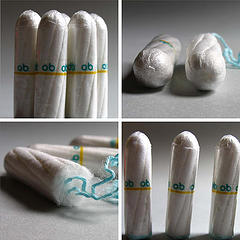
 For an average of five days per month, every month, many women are exposed to the ingredients that make up tampons and sanitary pads. You would think these items would be safe, especially since they come in contact with such a sensitive area, with potential to spread any product chemicals to the rest of the body.
For an average of five days per month, every month, many women are exposed to the ingredients that make up tampons and sanitary pads. You would think these items would be safe, especially since they come in contact with such a sensitive area, with potential to spread any product chemicals to the rest of the body.
Over the past few years, however, there has been concern about “dioxins” in these products, and what health dangers they may present to women. Dioxin is a by-product of the chlorine bleaching process and other manufacturing processes used to produce paper and rayon products. Tampons, for example, are usually made of cotton and rayon-rayon being a synthetic fiber made from wood pulp. During that process, dioxin is created. Up until the late 1990s, a chlorine bleaching process that also produces dioxin was used on both the rayon and cotton used in tampons. (Today’s bleaching process is chlorine free.)
The Environmental Protection Agency (EPA) has reported that dioxins are known to cause cancer in animals, and probably in people. They say that because dioxins are widely distributed throughout the environment, most people have detectable levels in their tissues, and that “this background exposure is likely to result in an increased risk of cancer.” Even lower levels of exposure can cause changes in hormone systems, alterations in fetal development, and the suppression of the immune system. Research on monkeys has linked dioxin exposure with increased risk of endometriosis, a painful disease in which uterine tissue is found outside the uterus, often leading to infertility.
New bleaching methods have reduced the dioxin in these products, but it’s still detected in tampons-even those made with 100% cotton. Dioxin is also found in the air (because of pollution), water, and ground, so it may be getting into the cotton or wood pulp raw materials. The amount is very small, and in a 2002 study published in Environmental Health Perspectives, researchers concluded that even if all the dioxin in tampons were absorbed into the body, the exposure would still be thousands of times less than what people get through the food they eat, and noted that tampons sold in health food stores were not safer than brand-name products.
We are exposed to dioxin in many ways. Most of us get it from the food we eat-from animal fats in beef, pork, fish, milk, and dairy products. Exposure to coal powered power plants, residential wood burning, backyard burning of household waste, forest fires, and other waste processing can also contribute to the dioxin burden we carry. In comparison, tampons may seem like a drop in the sea, but according to Dr. Philip Tierno, director of clinical microbiology and diagnostic immunology at the New York University Medical Center, even trace amounts are cause for concern because tampons come in contact with some of the most absorbent tissue in the body. The effects of dioxin are cumulative-it hangs around inside us for years. A woman may use over 16,000 tampons in her lifetime, so no wonder we’re concerned!
At this point, since current studies show little difference between brands of tampons and sanitary pads, our best action to take is to encourage policy changes in how dioxin is regulated. (You may want to look for all-cotton tampons that are unbleached, or switch to pads, since they have less contact with sensitive tissues.) In 1989, British women launched a publicity campaign to halt the use of chlorine gas bleaching processes and won. We, too, can write to our representatives and participate in community efforts to spread the word about dangerous chemicals in our everyday products.
Have you changed the products you use during your menstrual cycle as a result of these concerns? Please share your story.
Photo courtesy Mieke Miwian via Flickr.com.

